| Listing 1 - 10 of 27 | << page >> |
Sort by
|
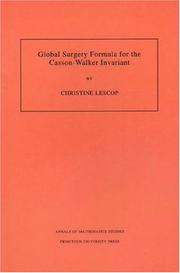
ISBN: 0691021333 1400865158 9781400865154 9780691021331 0691021325 9780691021324 Year: 1996 Volume: 140 Publisher: Princeton, New Jersey : Princeton University Press,
Abstract | Keywords | Export | Availability | Bookmark
 Loading...
Loading...Choose an application
- Reference Manager
- EndNote
- RefWorks (Direct export to RefWorks)
This book presents a new result in 3-dimensional topology. It is well known that any closed oriented 3-manifold can be obtained by surgery on a framed link in S 3. In Global Surgery Formula for the Casson-Walker Invariant, a function F of framed links in S 3 is described, and it is proven that F consistently defines an invariant, lamda (l), of closed oriented 3-manifolds. l is then expressed in terms of previously known invariants of 3-manifolds. For integral homology spheres, l is the invariant introduced by Casson in 1985, which allowed him to solve old and famous questions in 3-dimensional topology. l becomes simpler as the first Betti number increases. As an explicit function of Alexander polynomials and surgery coefficients of framed links, the function F extends in a natural way to framed links in rational homology spheres. It is proven that F describes the variation of l under any surgery starting from a rational homology sphere. Thus F yields a global surgery formula for the Casson invariant.
Chirurgie (Topologie) --- Drie-menigvuldigheden (Topologie) --- Heelkunde (Topologie) --- Surgery (Topology) --- Three-manifolds (Topology) --- Trois-variétés (Topologie) --- 3-manifolds (Topology) --- Manifolds, Three dimensional (Topology) --- Three-dimensional manifolds (Topology) --- Low-dimensional topology --- Topological manifolds --- Differential topology --- Homotopy equivalences --- Manifolds (Mathematics) --- Topology --- 515.16 --- 515.16 Topology of manifolds --- Topology of manifolds --- 3-manifold. --- Addition. --- Alexander polynomial. --- Ambient isotopy. --- Betti number. --- Casson invariant. --- Change of basis. --- Change of variables. --- Cobordism. --- Coefficient. --- Combination. --- Combinatorics. --- Computation. --- Conjugacy class. --- Connected component (graph theory). --- Connected space. --- Connected sum. --- Cup product. --- Determinant. --- Diagram (category theory). --- Disk (mathematics). --- Empty set. --- Exterior (topology). --- Fiber bundle. --- Fibration. --- Function (mathematics). --- Fundamental group. --- Homeomorphism. --- Homology (mathematics). --- Homology sphere. --- Homotopy sphere. --- Indeterminate (variable). --- Integer. --- Klein bottle. --- Knot theory. --- Manifold. --- Morphism. --- Notation. --- Orientability. --- Permutation. --- Polynomial. --- Prime number. --- Projective plane. --- Scientific notation. --- Seifert surface. --- Sequence. --- Summation. --- Symmetrization. --- Taylor series. --- Theorem. --- Topology. --- Tubular neighborhood. --- Unlink.

ISBN: 069108081X 9781400822492 1400822491 9780691080819 Year: 1971 Volume: 66 Publisher: Princeton (N.J.) : Princeton university press,
Abstract | Keywords | Export | Availability | Bookmark
 Loading...
Loading...Choose an application
- Reference Manager
- EndNote
- RefWorks (Direct export to RefWorks)
Intended for researchers in Riemann surfaces, this volume summarizes a significant portion of the work done in the field during the years 1966 to 1971.
Riemann surfaces --- Mathematics --- Physical Sciences & Mathematics --- Calculus --- Surfaces, Riemann --- Functions --- Congresses --- Differential geometry. Global analysis --- RIEMANN SURFACES --- congresses --- Congresses. --- MATHEMATICS / Calculus. --- Affine space. --- Algebraic function field. --- Algebraic structure. --- Analytic continuation. --- Analytic function. --- Analytic set. --- Automorphic form. --- Automorphic function. --- Automorphism. --- Beltrami equation. --- Bernhard Riemann. --- Boundary (topology). --- Canonical basis. --- Cartesian product. --- Clifford's theorem. --- Cohomology. --- Commutative diagram. --- Commutative property. --- Complex multiplication. --- Conformal geometry. --- Conformal map. --- Coset. --- Degeneracy (mathematics). --- Diagram (category theory). --- Differential geometry of surfaces. --- Dimension (vector space). --- Dirichlet boundary condition. --- Eigenfunction. --- Eigenvalues and eigenvectors. --- Eisenstein series. --- Euclidean space. --- Existential quantification. --- Explicit formulae (L-function). --- Exterior (topology). --- Finsler manifold. --- Fourier series. --- Fuchsian group. --- Function (mathematics). --- Generating set of a group. --- Group (mathematics). --- Hilbert space. --- Holomorphic function. --- Homeomorphism. --- Homology (mathematics). --- Homotopy. --- Hyperbolic geometry. --- Hyperbolic group. --- Identity matrix. --- Infimum and supremum. --- Inner automorphism. --- Intersection (set theory). --- Intersection number (graph theory). --- Isometry. --- Isomorphism class. --- Isomorphism theorem. --- Kleinian group. --- Limit point. --- Limit set. --- Linear map. --- Lorentz group. --- Mapping class group. --- Mathematical induction. --- Mathematics. --- Matrix (mathematics). --- Matrix multiplication. --- Measure (mathematics). --- Meromorphic function. --- Metric space. --- Modular group. --- Möbius transformation. --- Number theory. --- Osgood curve. --- Parity (mathematics). --- Partial isometry. --- Poisson summation formula. --- Pole (complex analysis). --- Projective space. --- Quadratic differential. --- Quadratic form. --- Quasiconformal mapping. --- Quotient space (linear algebra). --- Quotient space (topology). --- Riemann mapping theorem. --- Riemann sphere. --- Riemann surface. --- Riemann zeta function. --- Scalar multiplication. --- Scientific notation. --- Selberg trace formula. --- Series expansion. --- Sign (mathematics). --- Square-integrable function. --- Subgroup. --- Teichmüller space. --- Theorem. --- Topological manifold. --- Topological space. --- Uniformization. --- Unit disk. --- Variable (mathematics). --- Riemann, Surfaces de --- RIEMANN SURFACES - congresses --- Fonctions d'une variable complexe --- Surfaces de riemann
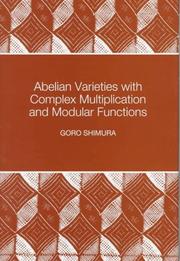
ISBN: 0691016569 1400883946 9780691016566 Year: 1998 Volume: 46 Publisher: Princeton (N.J.): Princeton university press,
Abstract | Keywords | Export | Availability | Bookmark
 Loading...
Loading...Choose an application
- Reference Manager
- EndNote
- RefWorks (Direct export to RefWorks)
Reciprocity laws of various kinds play a central role in number theory. In the easiest case, one obtains a transparent formulation by means of roots of unity, which are special values of exponential functions. A similar theory can be developed for special values of elliptic or elliptic modular functions, and is called complex multiplication of such functions. In 1900 Hilbert proposed the generalization of these as the twelfth of his famous problems. In this book, Goro Shimura provides the most comprehensive generalizations of this type by stating several reciprocity laws in terms of abelian varieties, theta functions, and modular functions of several variables, including Siegel modular functions. This subject is closely connected with the zeta function of an abelian variety, which is also covered as a main theme in the book. The third topic explored by Shimura is the various algebraic relations among the periods of abelian integrals. The investigation of such algebraicity is relatively new, but has attracted the interest of increasingly many researchers. Many of the topics discussed in this book have not been covered before. In particular, this is the first book in which the topics of various algebraic relations among the periods of abelian integrals, as well as the special values of theta and Siegel modular functions, are treated extensively.
Ordered algebraic structures --- 512.74 --- Abelian varieties --- Modular functions --- Functions, Modular --- Elliptic functions --- Group theory --- Number theory --- Varieties, Abelian --- Geometry, Algebraic --- Algebraic groups. Abelian varieties --- 512.74 Algebraic groups. Abelian varieties --- Abelian varieties. --- Modular functions. --- Abelian extension. --- Abelian group. --- Abelian variety. --- Absolute value. --- Adele ring. --- Affine space. --- Affine variety. --- Algebraic closure. --- Algebraic equation. --- Algebraic extension. --- Algebraic number field. --- Algebraic structure. --- Algebraic variety. --- Analytic manifold. --- Automorphic function. --- Automorphism. --- Big O notation. --- CM-field. --- Characteristic polynomial. --- Class field theory. --- Coefficient. --- Complete variety. --- Complex conjugate. --- Complex multiplication. --- Complex number. --- Complex torus. --- Corollary. --- Degenerate bilinear form. --- Differential form. --- Direct product. --- Direct proof. --- Discrete valuation ring. --- Divisor. --- Eigenvalues and eigenvectors. --- Embedding. --- Endomorphism. --- Existential quantification. --- Field of fractions. --- Finite field. --- Fractional ideal. --- Function (mathematics). --- Fundamental theorem. --- Galois extension. --- Galois group. --- Galois theory. --- Generic point. --- Ground field. --- Group theory. --- Groupoid. --- Hecke character. --- Homology (mathematics). --- Homomorphism. --- Identity element. --- Integer. --- Irreducibility (mathematics). --- Irreducible representation. --- Lie group. --- Linear combination. --- Linear subspace. --- Local ring. --- Modular form. --- Natural number. --- Number theory. --- Polynomial. --- Prime factor. --- Prime ideal. --- Projective space. --- Projective variety. --- Rational function. --- Rational mapping. --- Rational number. --- Real number. --- Residue field. --- Riemann hypothesis. --- Root of unity. --- Scientific notation. --- Semisimple algebra. --- Simple algebra. --- Singular value. --- Special case. --- Subgroup. --- Subring. --- Subset. --- Summation. --- Theorem. --- Vector space. --- Zero element.

ISBN: 0691032165 140088392X 9780691032160 Year: 1993 Volume: 43 Publisher: Princeton (N.J.): Princeton university press,
Abstract | Keywords | Export | Availability | Bookmark
 Loading...
Loading...Choose an application
- Reference Manager
- EndNote
- RefWorks (Direct export to RefWorks)
This book contains an exposition of some of the main developments of the last twenty years in the following areas of harmonic analysis: singular integral and pseudo-differential operators, the theory of Hardy spaces, Lsup estimates involving oscillatory integrals and Fourier integral operators, relations of curvature to maximal inequalities, and connections with analysis on the Heisenberg group.
Harmonic analysis. Fourier analysis --- Harmonic analysis --- Analyse harmonique --- Harmonic analysis. --- Analysis (Mathematics) --- Functions, Potential --- Potential functions --- Banach algebras --- Calculus --- Mathematical analysis --- Mathematics --- Bessel functions --- Fourier series --- Harmonic functions --- Time-series analysis --- Groupe de Heisenberg. --- Addition. --- Analytic function. --- Asymptote. --- Asymptotic analysis. --- Asymptotic expansion. --- Asymptotic formula. --- Automorphism. --- Axiom. --- Banach space. --- Bessel function. --- Big O notation. --- Bilinear form. --- Borel measure. --- Boundary value problem. --- Bounded function. --- Bounded mean oscillation. --- Bounded operator. --- Boundedness. --- Cancellation property. --- Cauchy's integral theorem. --- Cauchy–Riemann equations. --- Characteristic polynomial. --- Characterization (mathematics). --- Commutative property. --- Commutator. --- Complex analysis. --- Convolution. --- Differential equation. --- Differential operator. --- Dimension (vector space). --- Dimension. --- Dirac delta function. --- Dirichlet problem. --- Elliptic operator. --- Existential quantification. --- Fatou's theorem. --- Fourier analysis. --- Fourier integral operator. --- Fourier inversion theorem. --- Fourier series. --- Fourier transform. --- Fubini's theorem. --- Function (mathematics). --- Fundamental solution. --- Gaussian curvature. --- Hardy space. --- Harmonic function. --- Heisenberg group. --- Hilbert space. --- Hilbert transform. --- Holomorphic function. --- Hölder's inequality. --- Infimum and supremum. --- Integral transform. --- Interpolation theorem. --- Lagrangian (field theory). --- Laplace's equation. --- Lebesgue measure. --- Lie algebra. --- Line segment. --- Linear map. --- Lipschitz continuity. --- Locally integrable function. --- Marcinkiewicz interpolation theorem. --- Martingale (probability theory). --- Mathematical induction. --- Maximal function. --- Meromorphic function. --- Multiplication operator. --- Nilpotent Lie algebra. --- Norm (mathematics). --- Number theory. --- Operator theory. --- Order of integration (calculus). --- Orthogonality. --- Oscillatory integral. --- Poisson summation formula. --- Projection (linear algebra). --- Pseudo-differential operator. --- Pseudoconvexity. --- Rectangle. --- Riesz transform. --- Several complex variables. --- Sign (mathematics). --- Singular integral. --- Sobolev space. --- Special case. --- Spectral theory. --- Square (algebra). --- Stochastic differential equation. --- Subharmonic function. --- Submanifold. --- Summation. --- Support (mathematics). --- Theorem. --- Translational symmetry. --- Uniqueness theorem. --- Variable (mathematics). --- Vector field. --- Fourier, Analyse de --- Fourier, Opérateurs intégraux de
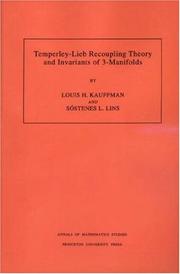
ISBN: 0691036411 0691036403 1400882532 9780691036403 9780691036410 Year: 1994 Volume: 134 Publisher: Princeton (N.J.): Princeton university press,
Abstract | Keywords | Export | Availability | Bookmark
 Loading...
Loading...Choose an application
- Reference Manager
- EndNote
- RefWorks (Direct export to RefWorks)
This book offers a self-contained account of the 3-manifold invariants arising from the original Jones polynomial. These are the Witten-Reshetikhin-Turaev and the Turaev-Viro invariants. Starting from the Kauffman bracket model for the Jones polynomial and the diagrammatic Temperley-Lieb algebra, higher-order polynomial invariants of links are constructed and combined to form the 3-manifold invariants. The methods in this book are based on a recoupling theory for the Temperley-Lieb algebra. This recoupling theory is a q-deformation of the SU(2) spin networks of Roger Penrose. The recoupling theory is developed in a purely combinatorial and elementary manner. Calculations are based on a reformulation of the Kirillov-Reshetikhin shadow world, leading to expressions for all the invariants in terms of state summations on 2-cell complexes. Extensive tables of the invariants are included. Manifolds in these tables are recognized by surgery presentations and by means of 3-gems (graph encoded 3-manifolds) in an approach pioneered by Sostenes Lins. The appendices include information about gems, examples of distinct manifolds with the same invariants, and applications to the Turaev-Viro invariant and to the Crane-Yetter invariant of 4-manifolds.
Drie-menigvuldigheden (Topologie) --- Knopentheorie --- Knot theory --- Noeuds [Theorie des ] --- Three-manifolds (Topology) --- Trois-variétés (Topologie) --- Knot theory. --- Algebraic topology --- Invariants --- Mathematics --- Invariants (Mathematics) --- Invariants. --- 3-manifolds (Topology) --- Manifolds, Three dimensional (Topology) --- Three-dimensional manifolds (Topology) --- Low-dimensional topology --- Topological manifolds --- Knots (Topology) --- 3-manifold. --- Addition. --- Algorithm. --- Ambient isotopy. --- Axiom. --- Backslash. --- Barycentric subdivision. --- Bijection. --- Bipartite graph. --- Borromean rings. --- Boundary parallel. --- Bracket polynomial. --- Calculation. --- Canonical form. --- Cartesian product. --- Cobordism. --- Coefficient. --- Combination. --- Commutator. --- Complex conjugate. --- Computation. --- Connected component (graph theory). --- Connected sum. --- Cubic graph. --- Diagram (category theory). --- Dimension. --- Disjoint sets. --- Disjoint union. --- Elaboration. --- Embedding. --- Equation. --- Equivalence class. --- Explicit formula. --- Explicit formulae (L-function). --- Factorial. --- Fundamental group. --- Graph (discrete mathematics). --- Graph embedding. --- Handlebody. --- Homeomorphism. --- Homology (mathematics). --- Identity element. --- Intersection form (4-manifold). --- Inverse function. --- Jones polynomial. --- Kirby calculus. --- Line segment. --- Linear independence. --- Matching (graph theory). --- Mathematical physics. --- Mathematical proof. --- Mathematics. --- Maxima and minima. --- Monograph. --- Natural number. --- Network theory. --- Notation. --- Numerical analysis. --- Orientability. --- Orthogonality. --- Pairing. --- Pairwise. --- Parametrization. --- Parity (mathematics). --- Partition function (mathematics). --- Permutation. --- Poincaré conjecture. --- Polyhedron. --- Quantum group. --- Quantum invariant. --- Recoupling. --- Recursion. --- Reidemeister move. --- Result. --- Roger Penrose. --- Root of unity. --- Scientific notation. --- Sequence. --- Significant figures. --- Simultaneous equations. --- Smoothing. --- Special case. --- Sphere. --- Spin network. --- Summation. --- Symmetric group. --- Tetrahedron. --- The Geometry Center. --- Theorem. --- Theory. --- Three-dimensional space (mathematics). --- Time complexity. --- Tubular neighborhood. --- Two-dimensional space. --- Vector field. --- Vector space. --- Vertex (graph theory). --- Winding number. --- Writhe.

ISBN: 9780691096278 0691096279 9786612087592 1400825105 1282087592 1400814243 9781400814244 9781400825103 9781282087590 Year: 2002 Publisher: Princeton, N.J. : Princeton University Press,
Abstract | Keywords | Export | Availability | Bookmark
 Loading...
Loading...Choose an application
- Reference Manager
- EndNote
- RefWorks (Direct export to RefWorks)
The modeling of stochastic dependence is fundamental for understanding random systems evolving in time. When measured through linear correlation, many of these systems exhibit a slow correlation decay--a phenomenon often referred to as long-memory or long-range dependence. An example of this is the absolute returns of equity data in finance. Selfsimilar stochastic processes (particularly fractional Brownian motion) have long been postulated as a means to model this behavior, and the concept of selfsimilarity for a stochastic process is now proving to be extraordinarily useful. Selfsimilarity translates into the equality in distribution between the process under a linear time change and the same process properly scaled in space, a simple scaling property that yields a remarkably rich theory with far-flung applications. After a short historical overview, this book describes the current state of knowledge about selfsimilar processes and their applications. Concepts, definitions and basic properties are emphasized, giving the reader a road map of the realm of selfsimilarity that allows for further exploration. Such topics as noncentral limit theory, long-range dependence, and operator selfsimilarity are covered alongside statistical estimation, simulation, sample path properties, and stochastic differential equations driven by selfsimilar processes. Numerous references point the reader to current applications. Though the text uses the mathematical language of the theory of stochastic processes, researchers and end-users from such diverse fields as mathematics, physics, biology, telecommunications, finance, econometrics, and environmental science will find it an ideal entry point for studying the already extensive theory and applications of selfsimilarity.
Self-similar processes. --- Distribution (Probability theory) --- Processus autosimilaires --- Distribution (Théorie des probabilités) --- 519.218 --- Self-similar processes --- 519.24 --- Distribution functions --- Frequency distribution --- Characteristic functions --- Probabilities --- Selfsimilar processes --- Stochastic processes --- Special stochastic processes --- 519.218 Special stochastic processes --- Distribution (Théorie des probabilités) --- Almost surely. --- Approximation. --- Asymptotic analysis. --- Autocorrelation. --- Autoregressive conditional heteroskedasticity. --- Autoregressive–moving-average model. --- Availability. --- Benoit Mandelbrot. --- Brownian motion. --- Central limit theorem. --- Change of variables. --- Computational problem. --- Confidence interval. --- Correlogram. --- Covariance matrix. --- Data analysis. --- Data set. --- Determination. --- Fixed point (mathematics). --- Foreign exchange market. --- Fractional Brownian motion. --- Function (mathematics). --- Gaussian process. --- Heavy-tailed distribution. --- Heuristic method. --- High frequency. --- Inference. --- Infimum and supremum. --- Instance (computer science). --- Internet traffic. --- Joint probability distribution. --- Likelihood function. --- Limit (mathematics). --- Linear regression. --- Log–log plot. --- Marginal distribution. --- Mathematica. --- Mathematical finance. --- Mathematics. --- Methodology. --- Mixture model. --- Model selection. --- Normal distribution. --- Parametric model. --- Power law. --- Probability theory. --- Publication. --- Random variable. --- Regime. --- Renormalization. --- Result. --- Riemann sum. --- Self-similar process. --- Self-similarity. --- Simulation. --- Smoothness. --- Spectral density. --- Square root. --- Stable distribution. --- Stable process. --- Stationary process. --- Stationary sequence. --- Statistical inference. --- Statistical physics. --- Statistics. --- Stochastic calculus. --- Stochastic process. --- Technology. --- Telecommunication. --- Textbook. --- Theorem. --- Time series. --- Variance. --- Wavelet. --- Website.
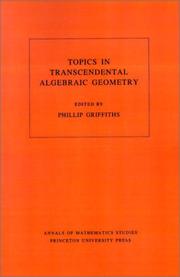
ISBN: 0691083355 0691083398 140088165X Year: 1984 Publisher: Princeton (N.J.) Princeton University Press
Abstract | Keywords | Export | Availability | Bookmark
 Loading...
Loading...Choose an application
- Reference Manager
- EndNote
- RefWorks (Direct export to RefWorks)
The description for this book, Topics in Transcendental Algebraic Geometry. (AM-106), Volume 106, will be forthcoming.
Geometry, Algebraic. --- Hodge theory. --- Torelli theorem. --- Géométrie algébrique --- Théorie de Hodge --- Geometry, Algebraic --- Hodge theory --- Torelli theorem --- 512.7 --- Torelli's theorem --- Curves, Algebraic --- Jacobians --- Complex manifolds --- Differentiable manifolds --- Homology theory --- Algebraic geometry --- Geometry --- Algebraic geometry. Commutative rings and algebras --- 512.7 Algebraic geometry. Commutative rings and algebras --- Géométrie algébrique --- Théorie de Hodge --- Abelian integral. --- Algebraic curve. --- Algebraic cycle. --- Algebraic equation. --- Algebraic geometry. --- Algebraic integer. --- Algebraic structure. --- Algebraic surface. --- Arithmetic genus. --- Arithmetic group. --- Asymptotic analysis. --- Automorphism. --- Base change. --- Bilinear form. --- Bilinear map. --- Cohomology. --- Combinatorics. --- Commutative diagram. --- Compactification (mathematics). --- Complete intersection. --- Complex manifold. --- Complex number. --- Computation. --- Deformation theory. --- Degeneracy (mathematics). --- Differentiable manifold. --- Dimension (vector space). --- Divisor (algebraic geometry). --- Divisor. --- Elliptic curve. --- Elliptic surface. --- Equation. --- Exact sequence. --- Fiber bundle. --- Function (mathematics). --- Fundamental class. --- Geometric genus. --- Geometry. --- Hermitian symmetric space. --- Hodge structure. --- Homology (mathematics). --- Homomorphism. --- Homotopy. --- Hypersurface. --- Intersection form (4-manifold). --- Intersection number. --- Irreducibility (mathematics). --- Isomorphism class. --- Jacobian variety. --- K3 surface. --- Kodaira dimension. --- Kronecker's theorem. --- Kummer surface. --- Kähler manifold. --- Lie algebra bundle. --- Lie algebra. --- Linear algebra. --- Linear algebraic group. --- Line–line intersection. --- Mathematical induction. --- Mathematical proof. --- Mathematics. --- Modular arithmetic. --- Module (mathematics). --- Moduli space. --- Monodromy matrix. --- Monodromy theorem. --- Monodromy. --- Nilpotent orbit. --- Normal function. --- Open set. --- Period mapping. --- Permutation group. --- Phillip Griffiths. --- Point at infinity. --- Pole (complex analysis). --- Polynomial. --- Projective space. --- Pullback (category theory). --- Quadric. --- Regular singular point. --- Resolution of singularities. --- Riemann–Roch theorem for surfaces. --- Scientific notation. --- Set (mathematics). --- Special case. --- Spectral sequence. --- Subgroup. --- Submanifold. --- Surface of general type. --- Surjective function. --- Tangent bundle. --- Theorem. --- Topology. --- Transcendental number. --- Vector space. --- Zariski topology. --- Zariski's main theorem.
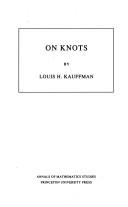
ISBN: 0691084343 0691084351 1400882133 9780691084343 Year: 1987 Volume: 115 Publisher: Princeton (N.J.): Princeton university press,
Abstract | Keywords | Export | Availability | Bookmark
 Loading...
Loading...Choose an application
- Reference Manager
- EndNote
- RefWorks (Direct export to RefWorks)
On Knots is a journey through the theory of knots, starting from the simplest combinatorial ideas--ideas arising from the representation of weaving patterns. From this beginning, topological invariants are constructed directly: first linking numbers, then the Conway polynomial and skein theory. This paves the way for later discussion of the recently discovered Jones and generalized polynomials. The central chapter, Chapter Six, is a miscellany of topics and recreations. Here the reader will find the quaternions and the belt trick, a devilish rope trick, Alhambra mosaics, Fibonacci trees, the topology of DNA, and the author's geometric interpretation of the generalized Jones Polynomial.Then come branched covering spaces, the Alexander polynomial, signature theorems, the work of Casson and Gordon on slice knots, and a chapter on knots and algebraic singularities.The book concludes with an appendix about generalized polynomials.
Knot theory --- Knots (Topology) --- Low-dimensional topology --- Knot theory. --- Algebraic topology --- 3-sphere. --- Addition theorem. --- Addition. --- Alexander polynomial. --- Algebraic variety. --- Algorithm. --- Ambient isotopy. --- Arf invariant. --- Basepoint. --- Bijection. --- Bilinear form. --- Borromean rings. --- Bracket polynomial. --- Braid group. --- Branched covering. --- Chiral knot. --- Chromatic polynomial. --- Cobordism. --- Codimension. --- Combination. --- Combinatorics. --- Complex analysis. --- Concentric. --- Conjecture. --- Connected sum. --- Conway polynomial (finite fields). --- Counting. --- Covering space. --- Cyclic group. --- Dense set. --- Determinant. --- Diagram (category theory). --- Diffeomorphism. --- Dimension. --- Disjoint union. --- Disk (mathematics). --- Dual graph. --- Elementary algebra. --- Embedding. --- Enumeration. --- Existential quantification. --- Exotic sphere. --- Fibration. --- Formal power series. --- Fundamental group. --- Geometric topology. --- Geometry and topology. --- Geometry. --- Group action. --- Homotopy. --- Integer. --- Intersection form (4-manifold). --- Isolated singularity. --- Jones polynomial. --- Knot complement. --- Knot group. --- Laws of Form. --- Lens space. --- Linking number. --- Manifold. --- Module (mathematics). --- Morwen Thistlethwaite. --- Normal bundle. --- Notation. --- Obstruction theory. --- Operator algebra. --- Pairing. --- Parity (mathematics). --- Partition function (mathematics). --- Planar graph. --- Point at infinity. --- Polynomial ring. --- Polynomial. --- Quantity. --- Rectangle. --- Reidemeister move. --- Remainder. --- Root of unity. --- Saddle point. --- Seifert surface. --- Singularity theory. --- Slice knot. --- Special case. --- Statistical mechanics. --- Substructure. --- Summation. --- Symmetry. --- Theorem. --- Three-dimensional space (mathematics). --- Topological space. --- Torus knot. --- Trefoil knot. --- Tubular neighborhood. --- Underpinning. --- Unknot. --- Variable (mathematics). --- Whitehead link. --- Wild knot. --- Writhe. --- Variétés topologiques --- Topologie combinatoire --- Theorie des noeuds
Book
ISBN: 9780691143415 0691143412 9786612458019 1282936077 1282458019 1400833884 9781400833887 9781282458017 9781282936072 Year: 2010 Publisher: Princeton, N.J. : Princeton University Press,
Abstract | Keywords | Export | Availability | Bookmark
 Loading...
Loading...Choose an application
- Reference Manager
- EndNote
- RefWorks (Direct export to RefWorks)
This computationally oriented book describes and explains the mathematical relationships among matrices, moments, orthogonal polynomials, quadrature rules, and the Lanczos and conjugate gradient algorithms. The book bridges different mathematical areas to obtain algorithms to estimate bilinear forms involving two vectors and a function of the matrix. The first part of the book provides the necessary mathematical background and explains the theory. The second part describes the applications and gives numerical examples of the algorithms and techniques developed in the first part. Applications addressed in the book include computing elements of functions of matrices; obtaining estimates of the error norm in iterative methods for solving linear systems and computing parameters in least squares and total least squares; and solving ill-posed problems using Tikhonov regularization. This book will interest researchers in numerical linear algebra and matrix computations, as well as scientists and engineers working on problems involving computation of bilinear forms.
Matrices. --- Numerical analysis. --- Mathematical analysis --- Algebra, Matrix --- Cracovians (Mathematics) --- Matrix algebra --- Matrixes (Algebra) --- Algebra, Abstract --- Algebra, Universal --- Matrices --- Numerical analysis --- Algorithm. --- Analysis of algorithms. --- Analytic function. --- Asymptotic analysis. --- Basis (linear algebra). --- Basis function. --- Biconjugate gradient method. --- Bidiagonal matrix. --- Bilinear form. --- Calculation. --- Characteristic polynomial. --- Chebyshev polynomials. --- Coefficient. --- Complex number. --- Computation. --- Condition number. --- Conjugate gradient method. --- Conjugate transpose. --- Cross-validation (statistics). --- Curve fitting. --- Degeneracy (mathematics). --- Determinant. --- Diagonal matrix. --- Dimension (vector space). --- Eigenvalues and eigenvectors. --- Equation. --- Estimation. --- Estimator. --- Exponential function. --- Factorization. --- Function (mathematics). --- Function of a real variable. --- Functional analysis. --- Gaussian quadrature. --- Hankel matrix. --- Hermite interpolation. --- Hessenberg matrix. --- Hilbert matrix. --- Holomorphic function. --- Identity matrix. --- Interlacing (bitmaps). --- Inverse iteration. --- Inverse problem. --- Invertible matrix. --- Iteration. --- Iterative method. --- Jacobi matrix. --- Krylov subspace. --- Laguerre polynomials. --- Lanczos algorithm. --- Linear differential equation. --- Linear regression. --- Linear subspace. --- Logarithm. --- Machine epsilon. --- Matrix function. --- Matrix polynomial. --- Maxima and minima. --- Mean value theorem. --- Meromorphic function. --- Moment (mathematics). --- Moment matrix. --- Moment problem. --- Monic polynomial. --- Monomial. --- Monotonic function. --- Newton's method. --- Numerical integration. --- Numerical linear algebra. --- Orthogonal basis. --- Orthogonal matrix. --- Orthogonal polynomials. --- Orthogonal transformation. --- Orthogonality. --- Orthogonalization. --- Orthonormal basis. --- Partial fraction decomposition. --- Polynomial. --- Preconditioner. --- QR algorithm. --- QR decomposition. --- Quadratic form. --- Rate of convergence. --- Recurrence relation. --- Regularization (mathematics). --- Rotation matrix. --- Singular value. --- Square (algebra). --- Summation. --- Symmetric matrix. --- Theorem. --- Tikhonov regularization. --- Trace (linear algebra). --- Triangular matrix. --- Tridiagonal matrix. --- Upper and lower bounds. --- Variable (mathematics). --- Vector space. --- Weight function.
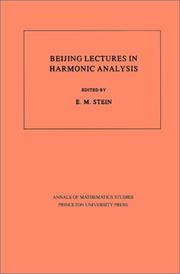
ISBN: 0691084181 069108419X 1400882095 Year: 1986 Publisher: Princeton (N.J.) Princeton University Press
Abstract | Keywords | Export | Availability | Bookmark
 Loading...
Loading...Choose an application
- Reference Manager
- EndNote
- RefWorks (Direct export to RefWorks)
Based on seven lecture series given by leading experts at a summer school at Peking University, in Beijing, in 1984. this book surveys recent developments in the areas of harmonic analysis most closely related to the theory of singular integrals, real-variable methods, and applications to several complex variables and partial differential equations. The different lecture series are closely interrelated; each contains a substantial amount of background material, as well as new results not previously published. The contributors to the volume are R. R. Coifman and Yves Meyer, Robert Fcfferman,Carlos K. Kenig, Steven G. Krantz, Alexander Nagel, E. M. Stein, and Stephen Wainger.
Harmonic analysis. --- Analysis (Mathematics) --- Functions, Potential --- Potential functions --- Banach algebras --- Calculus --- Mathematical analysis --- Mathematics --- Bessel functions --- Fourier series --- Harmonic functions --- Time-series analysis --- Analytic function. --- Asymptotic formula. --- Bergman metric. --- Bernhard Riemann. --- Bessel function. --- Biholomorphism. --- Boundary value problem. --- Bounded mean oscillation. --- Bounded operator. --- Boundedness. --- Cauchy's integral formula. --- Characteristic function (probability theory). --- Characterization (mathematics). --- Coefficient. --- Commutator. --- Complexification (Lie group). --- Continuous function. --- Convolution. --- Degeneracy (mathematics). --- Differential equation. --- Differential operator. --- Dirac delta function. --- Dirichlet problem. --- Equation. --- Estimation. --- Existence theorem. --- Existential quantification. --- Explicit formula. --- Explicit formulae (L-function). --- Fatou's theorem. --- Fourier analysis. --- Fourier integral operator. --- Fourier transform. --- Fredholm theory. --- Fubini's theorem. --- Function (mathematics). --- Functional calculus. --- Fundamental solution. --- Gaussian curvature. --- Hardy space. --- Harmonic function. --- Harmonic measure. --- Heisenberg group. --- Hilbert space. --- Hilbert transform. --- Hodge theory. --- Holomorphic function. --- Hyperbolic partial differential equation. --- Hölder's inequality. --- Infimum and supremum. --- Integration by parts. --- Interpolation theorem. --- Intersection (set theory). --- Invertible matrix. --- Isometry group. --- Laplace operator. --- Laplace's equation. --- Lebesgue measure. --- Linear map. --- Lipschitz continuity. --- Lipschitz domain. --- Lp space. --- Mathematical induction. --- Mathematical physics. --- Maximal function. --- Maximum principle. --- Measure (mathematics). --- Newtonian potential. --- Non-Euclidean geometry. --- Number theory. --- Operator theory. --- Oscillatory integral. --- Parameter. --- Partial derivative. --- Partial differential equation. --- Polynomial. --- Power series. --- Product metric. --- Radon–Nikodym theorem. --- Riemannian manifold. --- Riesz representation theorem. --- Scientific notation. --- Several complex variables. --- Sign (mathematics). --- Simultaneous equations. --- Singular function. --- Singular integral. --- Sobolev space. --- Square (algebra). --- Statistical hypothesis testing. --- Stokes' theorem. --- Support (mathematics). --- Tangent space. --- Tensor product. --- Theorem. --- Trigonometric series. --- Uniformization theorem. --- Variable (mathematics). --- Vector field.
| Listing 1 - 10 of 27 | << page >> |
Sort by
|

 Search
Search Feedback
Feedback About UniCat
About UniCat  Help
Help News
News